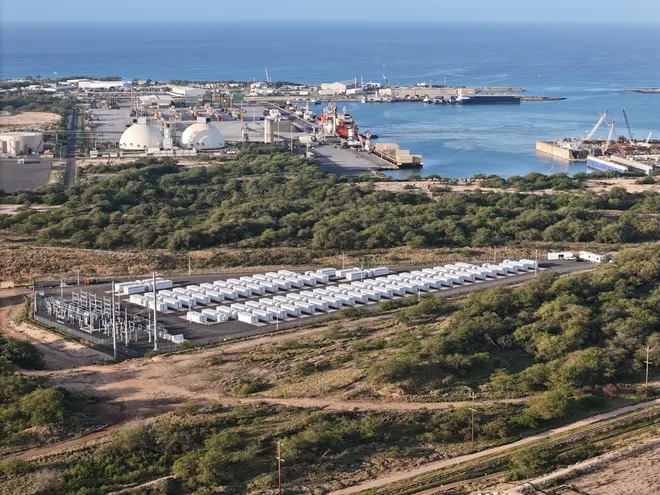Each of Hawaii’s six main islands has its own electrical grid, not connected to any other island. The state already gets 32% of its energy from renewables. Today 6.25% of Hawaii’s electricity comes from its seven wind farms. On the Big Island of Hawaii, about 30% of power comes from geothermal from a plant that gets heat from near the Kilauea volcano that erupted in September.
It’s also got a growing number of electric vehicles. Last year, 15% of new vehicle sales in Hawaii were electric.
It makes sense, said Mikulina. “Gas is expensive and we don’t have to drive very far, so the biggest hurdles of cost and range anxiety aren’t here,” he said.
But what makes the state stand out is solar power – especially where it comes from.
In 2022 Hawaii hit upon an innovative plan to make up for the shutdown of its last coal plant. State regulators created the Battery Bonus program, which subsidized households to add rooftop solar and battery storage.
In exchange, the household feeds electricity back into the grid for two hours sometime between 6 and 8:30 pm, when the sun has gone down and Hawaii needs power.
By the end of 2023, the island of Oahu enrolled 40 megawatts of power and Maui had added 6.29 megawatts.
There’s some controversy over new rules created for 2024 which are more complex and less favorable to customers, and the island’s solar industry has asked the state Public Utilities Commission to reconsider.
The state also has a number of utility-scale solar farms. The largest on the Big Island of Hawaii, the Waikoloa solar plus storage project, plugged in last year and now supplies more than 7% of the island’s electricity. “It’s in the middle of a lava field, and it’s already it’s lowering people’s bills at least $5 a month,” said Mikulina.
But the remarkable thing about Hawaii when it comes to sun is how many households have solar. A record 37% of Hawaiian homes have rooftop solar, which accounts for an impressive 44% of the state’s renewable energy.
The only place in the world that’s even remotely close to that is Australia, where 26% of that nation island’s energy comes from solar panels on people’s roofs.
“We talk to those guys a lot. They have very similar challenges to us,” said Ching.
Hawaii is proud of the amount of renewable power it has now. But to fulfill its state mandate, it’s going to need a lot more, quickly.
That’s where batteries come in.
Why you need a big battery
Three kinds of carbon-neutral power produce 24 hours a day – nuclear, hydroelectric and geothermal. But all are politically difficult to expand, which means wind and solar are the go-tos to meet the nation’s energy goals.
As detractors frequently point out, the wind doesn’t always blow and the sun doesn’t always shine. Grid-scale batteries help even things out. When there’s more power coming from wind and solar than can be used, the batteries are charged up, then they discharge when the wind slows or the sun goes down.
These batteries store so much energy they can bridge the gap between when energy from solar goes off the grid at sunset and when everyone finally turns out the lights to go to bed.
But Hawaii is in a class by itself. It has so much solar it can’t always use all the power those 200,000 or so homes with solar panels pump into the grid. When that happens, grid operators have to shut off either utility scale wind or solar, called “curtailment,” to keep things even.
With the new Kapolei battery, the island of Oahu will be able to add 10% more solar power without having to worry it will overload the system.
Grid services help going renewable
The Kapolei Energy Storage facility doesn’t just store lots of power, it also does some complicated and critical things that help with the state’s goal of going 100% renewable – things more batteries on the mainland will be doing in the coming years.
Think of an electric grid as a teeter-totter. On one end you’ve got energy coming in, on the other energy going out. If the in and out aren’t perfectly balanced, the system becomes unstable and can collapse.
“When you flip on a light switch a power plant somewhere is working a little harder,” said Brandon Keefe, executive chairman of Plus Power, the Texas-based company that built the Kapolei battery.
For the last 120 or so years, electric power grids have relied on fossil fuel plants whose operators constantly monitor the need for energy, powering up or down to keep the frequency of the system in balance. That first line of defense is called frequency regulation.
If frequency imbalances grow, the second line of defense is either speeding up or slowing down the already-spinning turbines in the plants – a process called inertia – to generate more electricity and fill the frequency imbalance.
The Kapolei Energy Storage facility can do both, providing what’s known as “synthetic inertia.”
“In 250 milliseconds, a little slower than a blink of an eye, we can race up and fill major gaps in the system,” Keefe said.
These kinds of batteries will allow Hawaii to eventually get rid of all its fossil fuel plants, said Ching.
The last state will be first into a green future
For tourists, nothing will change. The air will remain balmy, the ocean refreshing, the resorts enticing.
Hawaii will be a case study for the rest of the nation, said Mikulina. “We can be a living laboratory for what’s possible for clean energy.”
The one Achilles’ Heel to the state’s green dreams is the amount of aviation fuel required to bring the tourists that fuel its economy. That will take advances in sustainable aviation fuel.

